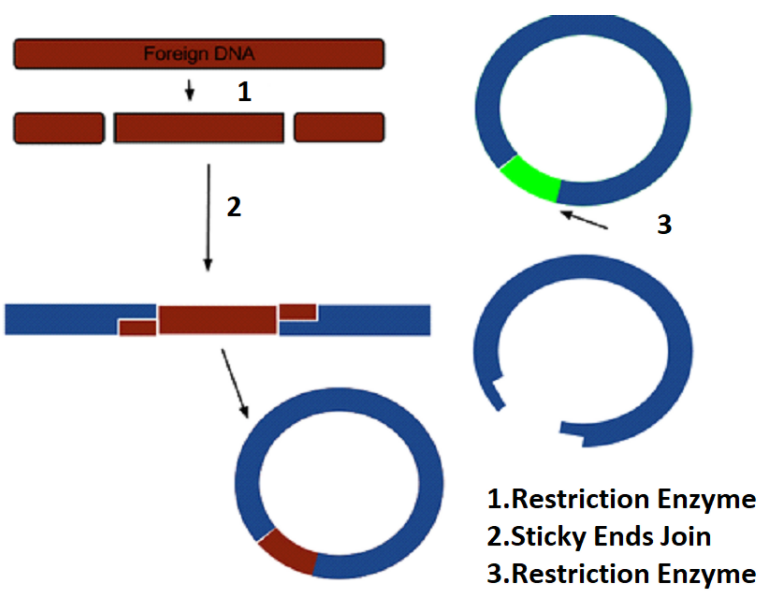
Restriction enzymes are called?
Answer
507k+ views
Hint: As we are aware of the name restriction enzymes in mostly biotechnology subjects. It is the most common tool; biological tool being used in the biotechnology field. Restriction enzymes as the name suggests are nothing but biological markers which are being produced to cleave or cut DNA at the desired specific sites.
Complete Explanation:
Restriction enzymes are commonly called restriction endonuclease. It is called endonuclease as it makes cuts from inside of the DNA strands. As we know that all enzymes are proteins but all proteins are not enzymes; theory. Hence restriction enzymes are also proteins which are being produced by bacteria. In the bacterial cell, restriction enzymes cleave foreign DNA, thus eliminating infecting organisms. Restriction enzymes are extracted from the bacterial cell in order to use in the laboratory to manipulate fragments of DNA. They are the indispensable tools which are used widely in recombinant DNA Technology. (GENETIC ENGINEERING).
Each restriction enzyme recognizes a specific strand or site which are short specific sequences of nucleotide bases (the four basic chemical subunits of the linear double-stranded DNA molecule) These regions are called recognition sequences or recognition sites. Different bacterial species make restriction enzymes which recognize different nucleotide sequences.
Typically, there are four types of restriction: enzymes are recognized, TYPE-I, II, III, IV.
1. TYPE I- this is the restriction enzyme which recognizes specific DNA sequences but makes their cut at random sites that can be as far as \[1000\] base pairs from the recognition site.
2. TYPE II- it is the enzyme which is recognized and cut directly within the recognition site. It is the most used or preferred restriction enzyme due to its correct identification techniques.
3. TYPE III- Specific sequences are recognized but appear to be cut at a specific location that is normally within approximately \[25\] base pairs of the recognition site.
Some examples of restriction endonucleases are- EcoB and EcoK are type I enzymes, while HindII and HindIII are type of II enzymes.
Note:
As we discussed the restriction enzymes or endonucleases in its examples, cutting mechanisms also enzymes are of two types- restriction endonuclease and restriction exonuclease. Endo as the name is known for the inner side so, it makes cuts from inward of the recognition site and exonuclease which means making cuts from the outward of the DNA strand. After cutting the strands from required sequences it is important to join the strands, Hence DNA ligase is an enzyme used for ligating the broken strands. It ligates strands at a specific temperature under suitable lab conditions.

Complete Explanation:
Restriction enzymes are commonly called restriction endonuclease. It is called endonuclease as it makes cuts from inside of the DNA strands. As we know that all enzymes are proteins but all proteins are not enzymes; theory. Hence restriction enzymes are also proteins which are being produced by bacteria. In the bacterial cell, restriction enzymes cleave foreign DNA, thus eliminating infecting organisms. Restriction enzymes are extracted from the bacterial cell in order to use in the laboratory to manipulate fragments of DNA. They are the indispensable tools which are used widely in recombinant DNA Technology. (GENETIC ENGINEERING).
Each restriction enzyme recognizes a specific strand or site which are short specific sequences of nucleotide bases (the four basic chemical subunits of the linear double-stranded DNA molecule) These regions are called recognition sequences or recognition sites. Different bacterial species make restriction enzymes which recognize different nucleotide sequences.
Typically, there are four types of restriction: enzymes are recognized, TYPE-I, II, III, IV.
1. TYPE I- this is the restriction enzyme which recognizes specific DNA sequences but makes their cut at random sites that can be as far as \[1000\] base pairs from the recognition site.
2. TYPE II- it is the enzyme which is recognized and cut directly within the recognition site. It is the most used or preferred restriction enzyme due to its correct identification techniques.
3. TYPE III- Specific sequences are recognized but appear to be cut at a specific location that is normally within approximately \[25\] base pairs of the recognition site.
Some examples of restriction endonucleases are- EcoB and EcoK are type I enzymes, while HindII and HindIII are type of II enzymes.
Note:
As we discussed the restriction enzymes or endonucleases in its examples, cutting mechanisms also enzymes are of two types- restriction endonuclease and restriction exonuclease. Endo as the name is known for the inner side so, it makes cuts from inward of the recognition site and exonuclease which means making cuts from the outward of the DNA strand. After cutting the strands from required sequences it is important to join the strands, Hence DNA ligase is an enzyme used for ligating the broken strands. It ligates strands at a specific temperature under suitable lab conditions.

Recently Updated Pages
A man running at a speed 5 ms is viewed in the side class 12 physics CBSE

State and explain Hardy Weinbergs Principle class 12 biology CBSE

Which of the following statements is wrong a Amnion class 12 biology CBSE

Two Planoconcave lenses 1 and 2 of glass of refractive class 12 physics CBSE

The compound 2 methyl 2 butene on reaction with NaIO4 class 12 chemistry CBSE

Bacterial cell wall is made up of A Cellulose B Hemicellulose class 12 biology CBSE

Trending doubts
Explain sex determination in humans with line diag class 12 biology CBSE

The pH of the pancreatic juice is A 64 B 86 C 120 D class 12 biology CBSE

Which prominent US inventor was known as the Wizard class 12 social science CBSE

Which state in India is known as the Granary of India class 12 social science CBSE

Draw a ray diagram of compound microscope when the class 12 physics CBSE

When was the first election held in India a 194748 class 12 sst CBSE




